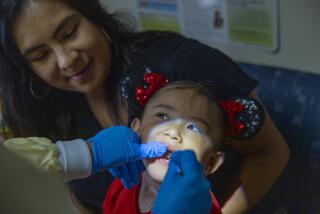New Devices Take Bite Out of Braces
- Share via
If you’ve been around teen-agers lately, you know orthodontics is not what it used to be.
The ear-to-ear gun-metal-gray “tin grin” look is still an option, but other choices abound:
* For the self-conscious, there are inconspicuous clear braces.
* For the flamboyant, there are glow-in-the-dark retainers.
* For the fickle, arch wires and retaining clips come in a rainbow of colors. You can even match your mouth to team colors, favorite outfits or holiday themes.
It’s not as frivolous as it might sound. Giving kids a choice, orthodontists say, gives them a sense of control. And that, in turn, makes them more likely to follow instructions on dental hygiene, diet and follow-up appointments.
But the advances in orthodontia aren’t just cosmetic. Arch wires--tiny wires slotted through brackets--have improved. Once made mostly of stainless steel, arch wires--which are tightened and changed to gently realign teeth--are now also made of a nickel-titanium combination that holds its shape better, thus reducing the need for adjustments.
“With nickel-titanium wires, there are lighter, continuous forces (on the teeth),” says Mike Lane, a spokesman for 3M Unitek, a Monrovia-based orthodontics manufacturer. “The wire has more ‘memory.’ ”
In recent years, clear and lingual braces have attracted self-conscious patients. (Clear braces are made from ceramic or plastic, and lingual braces are attached out of sight, to the back of the teeth.)
But there are trade-offs to these unconventional methods.
“The treatment time is longer with clear braces,” says Cabot Abel, a Santa Monica orthodontist. “Figure 25% to 50% longer. Figure 25% to 35% extra costs.”
Lingual, or “invisible,” braces are used less often today, says Patrick Turley, a UCLA associate professor of orthodontics and pediatric dentistry. “They are difficult to put in; they are difficult to adjust,” he says.
Lingual braces take longer to straighten teeth, and lingual patients spend more time in adjustment appointments than do those with traditional orthodontics.
Abel says lingual braces are not well-suited for children, who make up 75% of orthodontic patients. “They are more difficult to clean and more vulnerable to breakage,” he says. Even for optimal candidates, lingual braces are usually restricted to the more visible upper teeth, he says.
Whatever type of braces is deemed best, maintenance is vital. That means keeping follow-up appointments for adjustment sessions, usually every three to five weeks. Faithful toothbrushing is important too. Abel advises his patients to use a mechanized brush.
Avoiding certain foods also helps. Popcorn, hard candy and chewing gum are on most orthodontists’ forbidden lists.
“The cooperation we need is minimal,” Abel says. “But it is essential to good results.”
According to the experts, you should interview two or three orthodontists before deciding on one. Questions to ask:
Do you have special training in orthodontics?
Nationwide, about 8,000 orthodontists, or 90% of those practicing, belong to the American Assn. of Orthodontists. About 2,400 orthodontists are certified by the American Board of Orthodontics, says Thomas Graber, editor of the American Journal of Orthodontics. An orthodontist must have clinical experience and pass a rigorous exam to earn board certification.
What treatment and results should I expect?
An orthodontist should be able to describe your treatment plan in detail and explain the expected results. Some orthodontists use computer imaging, especially for adults, to display on a small monitor probable post-treatment appearance.
What will it cost?
On the average, says UCLA’s Turley, orthodontic treatment costs $3,000 to $4,000. Many orthodontists ask for a down payment, then offer monthly payment plans, often interest-free.
How long will treatment take?
It varies, depending on the problem and the patient’s age. The average is 18 months to three years, says Mike Dillon of the American Assn. of Orthodontists. Treatment may be longer if teeth need to be extracted or shorter if there is no overbite, just a few crooked front teeth.
For children, the most common age to begin treatment is about age 12 or 13, says Abel. By then, most children have their permanent teeth. Children with severely crooked teeth might need treatment as early as 7 or 8.
For information or to find an orthodontist in your area, call the American Assn. of Orthodontists: (800) 222-9969.


